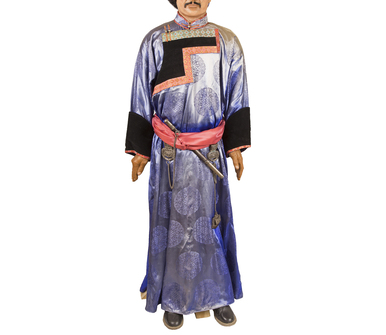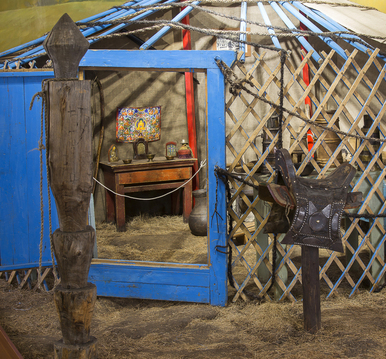A Buryat female costume is displayed in the Transbaikal Regional Museum of Local Lore. By its cut and additional elements, one could tell the age of the owner, as well as her family status and wealth.
Buryat girls wore long dresses or winter coats belted with a wide piece of fabric. At the age of 14–15 they had to change the hairstyle and wear a dress of a different cut: the previous one was cut along the waistline and a new skirt was attached to it, with a decorative braid covering the seam line.
The costume of a young woman consisted of a shirt, pants and a robe, which was worn over the rest of the clothes. The outfit was complemented by a sleeveless jacket, an obligatory element for married women in all Buryat tribes. The eastern Buryats wore one short vest. In western regions, a gathered skirt was sewn onto the back. The sleeveless jacket was decorated in the front with silver coins or mother-of-pearl buttons.
Women wore round hats which covered their heads. Red tassels were attached at the top, they symbolized sunrays in the sky. The lower part was decorated with beads, people believed this element of the hat to be connected with the earth. Pendants and earrings were attached to the headdress and fell down on the chest. They represented stars, the Sun, the Moon, rain or snow and were up to 75 centimeters in length.
An important part of the costume was intricate multi-piece jewelry, most often silver with coral, turquoise and amber inlays. Rings were worn on all fingers except the middle one, sometimes in several rows. Women wore silver bracelets on both hands and earrings in their ears.
Buryat women wore silver medallions of a square, triangular or round shape on their chests. Various ornaments were depicted on them, and prayers written in the Tibetan language were kept inside. The Khorinsky Buryats sowed shoulder ornaments on their robes or sleeveless jackets. They had a silver base with a coral inlay in the center. Threads made of beads, coral and pearls or silver chains with silk tassels fell down to the edges on both sides.
Buryat girls wore long dresses or winter coats belted with a wide piece of fabric. At the age of 14–15 they had to change the hairstyle and wear a dress of a different cut: the previous one was cut along the waistline and a new skirt was attached to it, with a decorative braid covering the seam line.
The costume of a young woman consisted of a shirt, pants and a robe, which was worn over the rest of the clothes. The outfit was complemented by a sleeveless jacket, an obligatory element for married women in all Buryat tribes. The eastern Buryats wore one short vest. In western regions, a gathered skirt was sewn onto the back. The sleeveless jacket was decorated in the front with silver coins or mother-of-pearl buttons.
Women wore round hats which covered their heads. Red tassels were attached at the top, they symbolized sunrays in the sky. The lower part was decorated with beads, people believed this element of the hat to be connected with the earth. Pendants and earrings were attached to the headdress and fell down on the chest. They represented stars, the Sun, the Moon, rain or snow and were up to 75 centimeters in length.
An important part of the costume was intricate multi-piece jewelry, most often silver with coral, turquoise and amber inlays. Rings were worn on all fingers except the middle one, sometimes in several rows. Women wore silver bracelets on both hands and earrings in their ears.
Buryat women wore silver medallions of a square, triangular or round shape on their chests. Various ornaments were depicted on them, and prayers written in the Tibetan language were kept inside. The Khorinsky Buryats sowed shoulder ornaments on their robes or sleeveless jackets. They had a silver base with a coral inlay in the center. Threads made of beads, coral and pearls or silver chains with silk tassels fell down to the edges on both sides.



